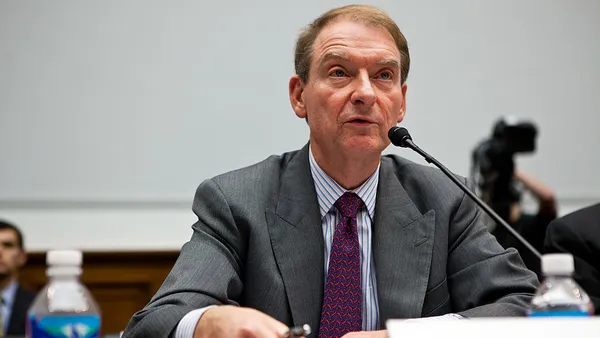Dive Brief:
- Companies benefit most when CFOs are freed up from day-to-day tasks so they can be full strategic partners of their CEOs, Bernard Huger, CFO of OneLogin, said in a CFO Thought Leader podcast.
- CFOs that have a trusted controller and other senior-level executives as part of their financial planning & analysis (FP&A) team can step back and determine the story the numbers are telling and help shape the direction of the company, says Huger, who started as a Wall Street investment banker before making the switch to CFO. “Finance is the essence of strategy,” he says in the podcast.
- Huger said the annual budget planning process is an opportunity for executives to come together and have a single picture of the challenges the company faces, a necessary first step for executives to get aligned on the solutions.
Dive Insight:
Huger says he follows three cardinal rules as a CFO: 1) Understand the story the numbers are telling you, 2) always relentlessly pursue the truth, and 3) learn from what you don't know as you find your footing.
He believes it helps that he rose through the ranks of investment banking, first at Stifel Nicolaus and then at JPMorgan, before he switched to the CFO role because it gave him a chance to hone his skill analyzing financials to really understand what the numbers are saying.
"I painfully learned the depths you have to go to get the right answer," he says. "Being able to answer any question that someone might have and to defend your point of view means foreseeing the questions yourself and answering them so you’re prepared and you’ve really thought through the problem you’re trying to solve."
It was this background in analysis that enabled him to make the switch to CFO, he says. The CEO of the company he applied to, Mulesoft, was looking for someone who could work with him more as a strategic partner than as an accountant. "I was told by recruiters that I needed to take the CPA exam to be taken seriously," he says. "But the person who ultimately hired me, Greg [Schott] at Mulesoft, was looking for someone . . . who could take the experience I had working with companies that had different business models, different levels of success, synthesize those, and help guide the company more strategically than perhaps some other people that he had interviewed for the same job." Mulesoft provides a platform for application development.
Based on that and subsequent CFO experiences, he now makes it his first priority to hire a team he can trust unequivocally so he can take his hands off the day-to-day controls and spend more time understanding what the numbers are saying.
"At OneLogin, I got lucky," he says. "One of the key people on my team was here when I joined and he’s been an absolute pleasure to work with. I’ve also added a really strong controller and head of legal, and these are my three right hands. Having this strong team has been a lesson that I frankly didn’t learn at the beginning. When I came into this role at OneLogin, I knew that was priority number one."
OneLogin is a subscription-based SaaS company that provides companies with access and identity management solutions for the cloud-based applications their employees use. To stay on top of how the company is doing, he looks at annual recurring revenue (ARR) in a variety of forms — how many they added in the quarter, how many they're retaining, and so on.
These are obvious metrics that any CFO must look at, he says. What's particularly informative to him, though, are metrics showing how well account executives are bringing in new business, so he looks at two data points related to that: 1) how quickly new account executives are ramping up, and 2) how much the company is spending getting these account executives to the point where they're succeeding.
"Hiring and ramping reps is the key to our business success in terms of being able to scale quickly and efficiently," he says. "If we can hire and ramp quickly, then all of the parts of the business are working well, and we’ll have predictability in our ability to grow and scale efficiently. When I see all parts are working well, if you’re hiring reps well, and you’re ramping them well, that means your HR and hiring processes are working right, you’re selecting the right people, and your sales enablement, marketing, and product are working well. The whole business comes together."
Huger says he specifically looks at the amount of time it takes a rep to ramp and who has succeeded by a certain date. "If we want to have all of these AEs ramp by three, six, or nine months, then in five or six months, has that account executive hit the ramp attainment rate success point? If they haven’t, maybe we should consider what to do with this person. But if you see that 90% of your hires are working out, then that’s great and it’s predictable. If only 30% are working out in that timeframe, then you’ve got some serious work to do. From there it’s peeling down the onion and understanding why."
The second metric — dollars of cost per account executive — shows how much money the company is spending on marketing, sales, and other support for the AE. "Many people will do that for the business as a whole in terms of how much you’re getting, or what’s your sales efficiency, or some of these other metrics," he says. "I like to look at it on a dollars-of-expense [basis] in supporting that AE: marketing and sales support and things like that. So, I think about the business on a unit basis in terms of account executives: how many of these folks are we hiring, how much are we spending on supporting them, how successful are they getting?"
Huger says CFOs are uniquely positioned to be the executive who can help bring all of the executives together on what the problems are and, from there, plotting a plan forward, because it's the CFO that has to create the financial model that the company will rely on.
He talks about a key moment in his career when the company was preparing to go into its annual planning process and he realized the executives weren't aligned on the problems or the solutions. It seemed pointless to create a financial plan for their upcoming meeting, he said, until everyone was at least seeing the same problems, and so he worked with the CEO to use the upcoming meeting as the starting point for getting everyone aligned.
"Anyone can create a financial model in Excel or whatever the system is, but that model isn’t worth anything unless you’ve got the team knitted together," he said. "So, my recommendation was to use the eight weeks that we had before our next executive off-site meeting to answer a set of questions that I drafted. So, we came up with six questions and we had eight weeks to work with the team to answer these questions and gather data, so when we get to the off-site, we’d be on path to agreeing to what our problems were and start making decisions.
"So, we did that," he went on, "and incredible things started to happen. For example, one day, six weeks into the process, we had a meeting to discuss one of these issues. That meeting started at seven and it was supposed to last for an hour. Around 2 p.m., the CEO was pounding the table and saying, “This is why you’re all wrong.” It was one of those moments where everyone got to really finally see what our CEO was thinking. It was a cathartic moment. After that, we started to really get through the issues and create an operating plan to resolve them. We had the off-site, started making decisions, got everyone on the same page, and then we built the model. Finance is the essence of strategy."
Huger says he sees finance moving in a positive direction as CEOs become more comfortable with hiring CFOs from outside the accounting field. "It’s exciting to see people with a broader set of backgrounds than the traditional accounting path entering into the senior ranks of finance," he says. "I think there’s a big opportunity for finance to take on more strategic roles within companies in terms of owning data, owning the truth, etc. I’m an analyst, essentially, and I see the opportunity an analyst has to drive excellence in a business in terms of focusing on the truth, driving fact-based decisions, and conveying good data throughout the organization so everyone can be aware of the facts and make decisions accordingly."
Access the podcast, hosted by Jack Sweeney of CFO Thought Leader.













